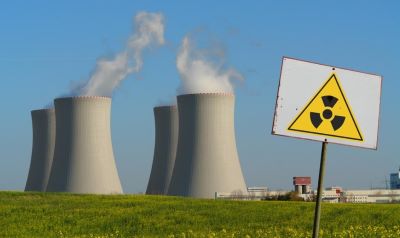Context
Nuclear power has long been hailed as a potential solution to the world's energy needs, offering a relatively clean and efficient source of electricity. However, alongside its benefits comes a formidable challenge: nuclear waste management. As nations like India embark on ambitious nuclear programs, such as their three-stage nuclear power initiative, the issue of handling and storing nuclear waste takes center stage. Understanding the nature of nuclear waste, its generation, management techniques, and associated challenges is crucial for ensuring the safe and sustainable utilization of nuclear energy.
Generation of Nuclear Waste
Nuclear waste is primarily generated within the core of nuclear reactors during the process of fission. When certain atomic nuclei, such as uranium-235, absorb neutrons, they become unstable and undergo fission, releasing energy and producing various radioactive byproducts. These byproducts, including fission fragments and transuranic elements, constitute nuclear waste. The spent fuel from nuclear reactors contains a complex mixture of these radioactive materials, presenting significant challenges for handling and disposal.
Characteristics and Hazards of Spent Fuel
The spent fuel from nuclear reactors is highly radioactive and poses significant risks to human health and the environment. It emits radiation that can penetrate human tissue, leading to various health effects, including cancer and genetic mutations. Additionally, the decay of radioactive isotopes within the spent fuel generates heat, requiring careful cooling to prevent overheating and potential accidents. Moreover, certain components of nuclear waste, such as plutonium, can be used in the production of nuclear weapons, further heightening security concerns.
Storage and Management of Nuclear Waste
Efficient and secure storage of nuclear waste is essential to minimize human exposure and environmental contamination. Initially, spent fuel is stored underwater in cooling pools to dissipate heat and reduce radiation levels. After a period of cooling, it can be transferred to dry cask storage for longer-term containment. This involves sealing the fuel assemblies within robust containers and placing them in designated storage facilities. Countries with significant nuclear programs, such as the United States, Canada, and Russia, have accumulated substantial inventories of spent fuel, necessitating robust storage infrastructure.
Liquid Waste Treatment
In addition to spent fuel, nuclear power plants produce liquid waste containing radioactive contaminants. These wastes are typically treated to remove radioactive isotopes before disposal. Treatment methods may include evaporation, chemical precipitation, or solid matrix absorption. However, the treatment process can vary depending on the specific contaminants present and the level of hazard they pose. Despite treatment efforts, the disposal of liquid high-level waste remains a concern due to its potential for environmental contamination and accident hazards.
Disposal Options and Challenges
Various disposal options have been proposed for nuclear waste, including geological disposal and reprocessing. Geological disposal involves burying waste containers deep underground in stable geological formations, such as granite or clay. While this approach offers long-term isolation from human activity, concerns remain about the potential for container degradation and groundwater contamination. Reprocessing, on the other hand, involves chemically separating fissile material from spent fuel for reuse. While reprocessing can improve fuel efficiency, it also generates additional waste and poses proliferation risks.
Challenges and Uncertainties
Despite efforts to manage nuclear waste, significant challenges and uncertainties persist. Instances of waste contamination, such as the Asse II salt mine in Germany, highlight the potential risks associated with improper storage and disposal. Additionally, accidents like the 2014 incident at the Waste Isolation Pilot Plant in the United States underscore the need for robust safety measures and continuous monitoring. Moreover, uncertainties surround the effectiveness of waste treatment technologies and the long-term viability of disposal methods, raising concerns about the potential costs and risks of nuclear waste management.
Costs of Waste Management
The management of nuclear waste imposes significant costs on the nuclear power industry. Estimates suggest that waste management accounts for a substantial portion of the total lifecycle costs of nuclear energy production. These costs encompass various activities, including waste handling, plant decommissioning, and fuel cycle management. Despite advancements in waste management technologies, the financial burden associated with nuclear waste remains a key consideration for policymakers and industry stakeholders.
Nuclear Waste Management in India
India, like many other nations with nuclear power programs, faces challenges in managing nuclear waste effectively. The country operates reprocessing plants in Trombay, Tarapur, and Kalpakkam to handle spent fuel and produce plutonium for use in reactors and weapons. Additionally, on-site facilities manage low and intermediate-level waste generated during reactor operations. However, delays in the commissioning of facilities like the Prototype Fast Breeder Reactor raise concerns about the adequacy of India's waste management infrastructure. As India continues to expand its nuclear capabilities, addressing these challenges will be critical to ensuring the safe and sustainable utilization of nuclear energy.
Conclusion
Nuclear waste management is a complex and multifaceted challenge that accompanies the utilization of nuclear energy. The generation of highly radioactive spent fuel necessitates careful handling and disposal to mitigate risks to human health and the environment. Various storage and disposal options exist, each with its own advantages and challenges. However, uncertainties surrounding the long-term effectiveness and safety of these methods underscore the need for continuous research and development in nuclear waste management technologies. As nations like India pursue ambitious nuclear programs, addressing the challenges of nuclear waste management will be essential to realizing the potential benefits of nuclear energy while minimizing its risks.
|
Probable Questions for UPSC Mains Exam
|
Source – The Hindu








